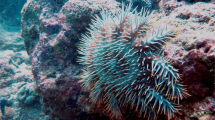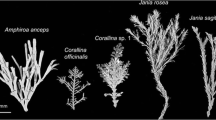Summary
A short-term experiment was conducted to examine the relationships among the branching coral Porites porites, algal epibionts, and a facultative crab associate Mithrax sculptus in Belize, Central America. Initial field observations suggested that coral colonies supporting resident crabs generally had lower algal cover than colonies without crabs. The hypothesis was tested that Mithrax significantly depresses host coral algal cover and thereby indirectly affects host survivorship and growth. Crab accessibility to an array of coral colonies, similarly covered with algal epibionts, was manipulated in three treatments. Results strongly support the hypothesis, with significant differences in algal cover (primarily Dictyota spp.) noted among treatments after only one month. Caged heads with crabs included and uncaged natural controls allowing crabs free access averaged less than 10% cover, whereas mean algal cover exceeded 75% where crabs were excluded. The uncaged treatment, in which crabs were allowed free access to Porites heads was not significantly different from the crab inclusion treatment. Collectively, these results demonstrate that under natural conditions, crabs can have pronounced effects on host corals by reducing fouling algal epibionts. Furthermore, these facultative coral associates may have more important, albeit localized effects on Caribbean corals than has been suggested previously.
Similar content being viewed by others
References
Abele LG (1984) Biogeography, colonization, and experimental community structure of coral-associated crustaceans. In: Strong DR Jr, Simberloff D, Abele LG, Thistle AB (eds) Ecological communities: conceptual issues and the evidence. Princeton University Press, Princeton, NJ, pp 123–137
Benzing D, Seeman J (1978) Nutritional piracy and host decline: a new perspective on the epiphyte-host relationship. Selbyana 2:133–148
Birkeland C (1977) The importance of rate of biomass accumulation in early successional stages of benthic communities to the survival of coral recruits. Proc Third Int Coral Reef Symp Miami, vol 1, pp 15–21
Black R (1976) The effects of grazing by the limpet Acmaea insessa on the kelp Egregia laevigata, in the intertidal zone. Ecology 57:265–277
Black R, Prince J (1983) Fauna associated with the coral Pocillopora damicornis at the southern limit of its distribution in Western Australia. J Biogeogr 10:135–152
Borowitzka MA (1981) Algae and grazing in coral reef ecosystems. Endeavor 5:99–106
Brawley SH, Adey WH (1981) The effects of micrograzers on algal community structure in a coral reef microcosm. Mar Biol 6:167–177
Carpenter RC (1986) Partitioning herbivory and its effects on coral reef algal communities. Ecol Monogr 56:345–363
Castro P (1976) Brachyuran crabs symbiotic with scleractinian corals: a review of their biology. Micronesica (J Coll Guam) 12:99–110
Coen LD (1987) Plant-animal interactions: ecology and comparative functional morphology of plant-grazing decapod (Brachyuran) crustaceans. PhD Dissertation, University of Maryland, College Park
D'Antonio C (1985) Epiphytes on the rocky intertidal red alga Rhodomela larix (Turner) C. Agardh: negative effects on the host and food for herbivores? J Exp Mar Biol Ecol 86:197–218
Dart JKG (1972) Eclinoids, algal lawns and coral recolonization. Nature 239:50–51
Day RW (1983) Effects of benthic algae on sessile animals: observational evidence from coral reef habitats. Bull Mar Sci 33:597–605
Dodge RE, Wyers SC, Frith HR, Knapp AH, Smith SR, Cook CB, Sleeter TD (1984) Coral calcification rates by the buoyant weight technique: effects of alizarin staining. J Exp Mar Biol Ecol 75:217–232
Filion-Myklebust C, Norton TA (1981) Epidermis shedding in the brown seaweed Ascophyllum nodosum (L.) LeJolis, and its ecological significance. Mar Biol Lett 2:45–51
Gaines SD (1985) Herbivory and between-habitat diversity: the differential effectiveness of defenses in a marine plant. Ecology 66:473–485
Gaines SD, Lubchenco J (1982) A unified approach to marine plant herbivore interactions. II. Biogeography. Annu Rev Ecol Syst 13:111–138
Glynn PW (1973) Aspects of the ecology of coral reefs in the western Atlantic region. In: Jones OA, Endean R (eds) Biology and geology of coral reefs, Vol II, Biology 1. Academic Press, New York, pp 271–324
Glynn PW (1981) Acanthaster population regulation by a shrimp and a worm. Proc Fourth Int Coral Reef Symp, Manila, vol 2, pp 607–612
Glynn PW (1983a) Increased survivorship in corals harboring crustacean symbionts. Mar Biol Lett 4:105–111
Glynn PW (1983b) Crustacean symbionts and the defense of corals: coevolution on the reef? In: Nitecki MH (ed) Coevolution. University of Chicago Press, Chicago, Ill, pp 111–178
Harrison PG (1982) Control of microbial growth and of amphipod grazing by water-soluble compounds from leaves of Zostera marina. Mar Biol 67:225–230
Hawkins SJ, Hartnoll RG (1983) Grazing of intertidal algae by marine invertebrates. Oceanogr Mar Biol 21:195–282
Hay ME (1984) Patterns of fish and urchin grazing on Caribbean coral reefs: are previous results typical? Ecology 65:446–454
Hay ME (1986) Associational plant defenses and the maintenance of species diversity: turning competitors into accomplices. Am Nat 128:617–641
Howard RK, Short FT (1986) Seagrass growth and survivorship under the influence of epiphyte grazers. Aquatic Bot 24:287–302
Huston MA (1985) Patterns of species diversity on coral reefs. Annu Rev Ecol Syst 16:149–177
Janzen DH (1967) Interaction of the Bull's-Horn Acacia (Acacia cornigera L) with an ant inhabitant (Pseudomyrmex ferruginea F Smith) in eastern Mexico. Univ Kansas Sci Bull 47:315–558
Johnson CR, Mann KH (1986a) The crustose coralline alga, Phymatolithon Foslie, inhibits the overgrowth of seaweeds without relying on herbivores. J Exp Mar Biol Ecol 96:127–146
Johnson CR, Mann KH (1986b) The importance of plant defence abilities to the structure of subtidal seaweed communities: the kelp Laminaria longicruris de la Pylaie survives grazing by the snail Lacuna vincta (Montagu) at high population densities. J Exp Mar Biol Ecol 97:231–267
Kennelly SJ (1983) An experimental approach to the study of factors affecting algal colonization in a subtidal kelp forest. J Exp Mar Biol Ecol 68:257–276
Lamberts AE (1978) Coral growth: alizarin method. In: Stoddart DR, Johannes RE (eds) Coral reefs: research methods, UNESCO Monographs Oceanographic Methodology #5, pp 523–527
Lawrence JM (1975) On the relationships between marine plants and sea urchins. Oceanogr Mar Biol 13:213–286
Lewis JB, Axelson F, Goodbody I, Page C, Chislett G (1968) Comparative growth rates of some corals in the Caribbean. Mar Sci Manu Rep 10, McGill University, pp 1–26
Lewis SM (1985) Herbivory on coral reefs: algal susceptibility to herbivorous fishes. Oecologia (Berlin) 65:370–375
Lewis SM (1986) The role of the herbivorous fishes in the organization of a Caribbean reef community. Ecol Monogr 56:183–200
Littler MM, Taylor PR, Littler DS (1986) Plant defense associations in the marine environment. Coral Reefs 5:63–71
Lubchenco J (1983) Littorina and Fucus: effects of herbivores, substratum, heterogeneity, and plant escapes during succession. Ecology 64:1116–1123
Lubchenco J, Gaines SD (1981) A unified approach to marine plant-herbivore interactions. I. populations and communities. Annu Rev Ecol Syst 12:405–437
Nadkarni NM (1981) Canopy roots: convergent evolution in rain-forest nutrient cycles. Science 214:1023–1024
Ogden JC, Lobel P (1978) The role of herbivorous fishes and urchins in coral reef communities. Environ Biol Fishes 3:49–63
Orth RJ, Van Montfrons J (1984) Epiphyte-seagrass relationships with an emphasis on the role of micrograzing: a review. Aquatic Bot 18:43–69
Paine RT (1980) Food webs: linkage, interaction strength and community infrastructure. J Anim Ecol 49:667–685
Patton WK (1974) Community structure among animals inhabiting the coral Pocillopora damicornis at Heron Island, Australia. In: Vernberg WB (ed) Symbiosis in the Sea. The Belle Baruch, Library in Marine Science Number 2, University of South Carolina Press, Columbia, South Carolina, pp 219–243
Potts DC (1977) Suppression of coral populations by filamentous algae within damselfish territories. J Exp Mar Biol Ecol 28:207–216
Randall JE (1967) Food habits of reef fishes of the West Indies. Stud Trop Oceanogr 5:665–847
Rützler K, Macintyre IG (eds) (1982) The Atlantic Barrier Reef ecosystem at Carrie Bow Cay, Belize. Smithson Contrib Mar Sci 12:1–539
Sammarco PW (1980) Diadema and its relationship to coral spat mortality: grazing, competition and biological disturbance. J Exp Mar Biol Ecol 45:245–272
Shacklock PF, Doyle RW (1983) Control of epiphytes in seaweed cultures using grazers. Aquaculture 31:141–151
Schupp EW (1986) Azteca protection of Cecropia: ant occupation benefits juvenile trees. Oecologia (Berlin) 70:379–385
Sokal RR, Rohlf FJ (1981) Biometry, 2nd. Freeman and Sons, San Francisco, Calif
Steneck RS (1982) A limpet-coralline alga association: adaptations and defenses between a selective predator and its prey. Ecology 63:507–522
Steneck RS (1983) Escalating herbivory and resulting adaptive trends in calcareous algal crusts. Paleobiol 9:44–61
Vine PJ (1974) Effects of algal grazing and aggressive behavior of fishes Pomacentrus lividus and Acanthurus sohal on coral reef ecology. Mar Biol 24:131–136
Wanders JBW (1977) The role of benthic algae in the shallow reef of Curacao (Netherlands Antilles) III. The significance of grazing. Aquatic Bot 3:357–390
Warner GF (1977) The biology of crabs. Van Nostrand, New York
Wellington GM (1982) Depth zonation of corals in the Gulf of Panama: control and facilitation by resident reef fishes. Ecol Monogr 52:223–241
Author information
Authors and Affiliations
Rights and permissions
About this article
Cite this article
Coen, L.D. Herbivory by crabs and the control of algal epibionts on Caribbean host corals. Oecologia 75, 198–203 (1988). https://doi.org/10.1007/BF00378597
Received:
Issue Date:
DOI: https://doi.org/10.1007/BF00378597




